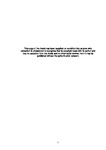A GARDEN IN HER CUPS: BOTANICAL MEDICINES OF THE ANGLO-AMERICAN HOME, C.1580 – 1800
| dc.contributor.supervisor | Daybell, James | |
| dc.contributor.author | Gushurst-Moore, Bruna | |
| dc.contributor.other | Faculty of Arts, Humanities and Business | en_US |
| dc.date.accessioned | 2013-01-22T12:00:31Z | |
| dc.date.available | 2013-01-22T12:00:31Z | |
| dc.date.issued | 2012 | |
| dc.identifier | 10169745 | en_US |
| dc.identifier.uri | http://hdl.handle.net/10026.1/1253 | |
| dc.description | The parameters delineating this study were chosen in order to accommodate the nature of the inquiry, allowing for fuller definitions, tracing, and consideration of the nature and role of domestic medicines and domestic medical provision in common use within the Anglo-American domestic sphere. As a result, the thesis has purposefully included manuscript evidence from the American colonies alongside those of English authors as a means of assessing the widespread Anglo-American cultural application of domestic medicine throughout the period. This strategy has three aims: first to consider more fully and flesh out the ‘greater British’ domestic knowledge and use of botanical medicines, and secondly, to examine what new medicines found their way into the European canon, with a consideration of how English materia medica changed, or not, as a result of this influx of new world flora. The third area of focus examines the retransmission of this British household use of indigenous American plants back to the American colonies, considering how trans-Atlantic practices adopted, and adapted, these botanicals by the end of the eighteenthcentury. It is by combining social history methods relative to chronology and geography in a cultural analysis of domestic plant-based medicines that a specific domestic practice is established. | en_US |
| dc.description.abstract |
This thesis focuses on the domestic use of plant-based medicines within Early Modern English and Colonial American households, and establishes the defining framework of a domestic botanical culture. It reconstructs the relationship between domestic, popular, and learned medical cultures to reveal the breadth of that practice, demonstrating the unique characteristics of the domestic culture which are underpinned by a shared canon of herbs and a high degree of flexible adaptability by individual practitioners. The botanicals (medicinal plants and the remedies made from them) are themselves analysed through the genres of household receipt book manuscripts, private letters, and journals, as well as almanacs, vernacular medical books, travel writing and settler texts in order to explore more fully and expand our understanding of the domestic culture within a broad social setting. Oral, scribal, and print networks are reconstructed in order to demonstrate that domestic medical practitioners shared a distinctive and influential medical construct, commonly portrayed by current scholarship as a mere reflection of popular and learned practices. Close engagement with both Early Modern English and Colonial women’s receipt books in particular reveals a commonality of practice based upon a shared materia medica which was sensitive and responsive to individual adaptation. Old and new world herbs are examined as a means of providing ingress into this shared and communal domestic practice, as well as to highlight the prevalence and importance of household individualization. The clear commonality of plants in trans-Atlantic domestic use demonstrates a continuous, shared, inherited practice which ends only with eighteenth-century Colonial inclusion of indigenous plants not found in the shared canon. Contemporary views of Early Modern and Colonial domestic medical practice are explored in order to argue that far from simply reflecting learned medical thinking and practice, domestic knowledge and use of botanical medicines was uniquely practical, communal, and flexible in its administration and expression. | en_US |
| dc.language.iso | en | en_US |
| dc.publisher | University of Plymouth | en_US |
| dc.subject | History of Medicine | en_US |
| dc.subject | Botanical Medicine | en_US |
| dc.subject | Trans-Atlantic Culture | en_US |
| dc.subject | Domestic Cultures | en_US |
| dc.subject | Early American History | en_US |
| dc.subject | Transmission Theory | en_US |
| dc.title | A GARDEN IN HER CUPS: BOTANICAL MEDICINES OF THE ANGLO-AMERICAN HOME, C.1580 – 1800 | en_US |
| dc.type | Thesis | |
| plymouth.version | Full version | en_US |
| dc.identifier.doi | http://dx.doi.org/10.24382/3883 |
Files in this item
This item appears in the following Collection(s)
-
01 Research Theses Main Collection
Research Theses Main


